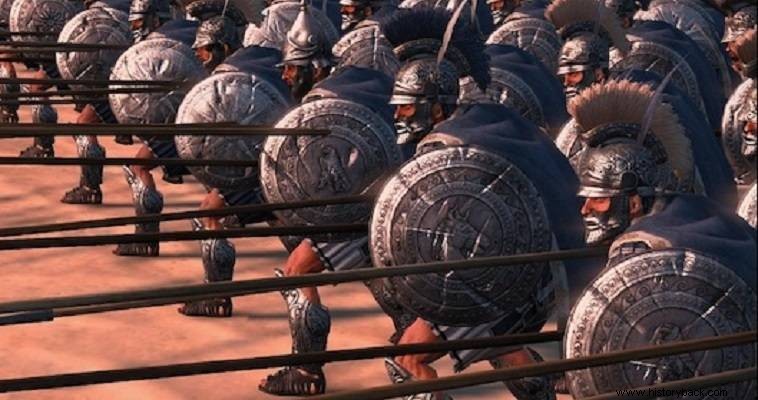
The Macedonian army of the Antionid period (277 – 167 BC) was just the memory of the mighty army of Philip II and Alexander. The constant wars had exhausted the human resources and the economic potential of the Macedonian kingdom.
When Antigonus Gonatas assumed the throne in 277 BC. he found the state destroyed by the invasion of the Gauls, which he himself repulsed. The great wound of the late Macedonian army of the time was the lack of valuable and numerous cavalry.
This weakness was covered for a time by the war elephants he had brought from Asia. But the last elephants died around 260 BC. and since then they did not join the Macedonian army again. In the 110 or so years that the Antigonides reigned in Macedonia, no serious changes occurred in the organization of the army.
The bulk of the infantry was made up of the sarissa-bearing foot soldiers, the Lefkaspides and the Chalcaspides . The phalanx was organized in Classes, just like under Alexander. But now each Order had eight regiments (or spirals) of 256 men each.
Each regiment had four tetrarchy of 64 men. Each Class extended 2,048 men. Usually two Classes constituted a Strategy. 8,000 Chalkaspides and 8,000 Lefkaspides fought in the battle of Kynos Kefali (197 BC).
The old Agima of the supporters still existed. At times it numbered between 3,000 and 5,000 men. The phalanx was flanked by shield-bearers and Thracian peltasts, small spearmen and slingers, mainly, and Gallic mercenaries.The cavalry, heavy and light, were armed with javelins and shields.
The men of the heavy cavalry carried breastplates. The cavalry was generally small in number. In the battle of Sellasia there were only 300 Macedonian horsemen, but also 600 southern Greek allies and 300 mercenaries. In the disastrous battle of Kynos Kefali, King Philip V had only 2,000 Macedonian and Thessalian horsemen. But later the son of Perseus had 3,000 Macedonian horsemen.
One of the islands, the chosen "Royal" was part of the royal guard and numbered 300-400 men. The mercenary horsemen were mainly Thracians but also Gauls and Illyrians.
Generally the mercenary and allied bodies were numerous. In Sellasia there were 3,300 mercenaries and 8,600 allied infantry and cavalry. There were also numerous Cretan archers who served in the Antigonid armies. King Perseus marshalled 3,000 of them at Pydna in 168 BC. along with about 1,000 elite gatekeeper mercenary peltasts.
Galatians were mainly recruited by Antigonus Gonatas. His successors recruited Gauls in smaller numbers. Antigonus Doson had 1,000 in Sellasia, while Perseus had 2,000 in Pydna. Perseus tried to recruit a body of 20,000 Gauls but failed.
The Thracians were also numerous. They were peltasts armed with javelins or lances and small spearmen, like the famous Agrianes and slingers. The presence of Illyrians who were traditional enemies of Greek Macedonians was smaller. Finally, the presence of a small number of Romans, mostly deserters, has been recorded.
The Macedonian army of the period was relatively small in number – it never exceeded 60,000 men. But the worst thing was that this army constituted the last vestige of strength of the Macedonian kingdom.
On the contrary, the Romans had inexhaustible potential and resources. However, the treacherous attitude of the Aetolians and the Pergamnian Greeks played a decisive role in the defeat and submission of the Macedonians to Rome.
Under solid leadership the army performed from satisfactory to excellent. Unfortunately in the conflicts with the Romans the leadership proved to be rather unsuitable.
